
The Life and Times of Hubert Brooks M.C. C.D.
A Canadian Hero

 |
|
 |
In 1914 sons Alfred and Aimé, with the then common dreams of a pioneer, decided to better their lives and travelled by train to Athabasca and then worked their way to Grouard just east of Slave Lake. They stayed around Grouard for a while and then decided to look for land farther west. Purchasing a saddle horse they made their way from Grouard to south of the hamlet of Old Bluesky to make their fortune in the fur business.
Ed Dodge who opened the first post office along with his wife and brother,is said to have named the growing hamlet "BLUESKY" because blue sky and brush were everywhere and he did not want to it "Brush". (Ed was the son of Adam and Sarah Dodge one of the first settlers in the area circa 1909.) The name Bluesky was accepted by "Peace River Jim" Cornwall who was the post office inspector at that time. The Old Bluesky hamlet is claimed to be the first district to be established within the greater Whitelaw region. The greatest influx of settlers arrived from 1913 to 1918.
There were many fur trading posts in the area at that time, perhaps the largest being just west of the brothers along the Peace River at Dunvegan.
Through the years, Alfred allegedly became ‘known’ within the extended Brooks family, perhaps harshly, as the ‘dreamer and schemer’ constantly thinking of the next ‘get rich scheme’ to be financed mostly by his father Hubert. Unfortunately each venture met with less than desired results.
In late 1915 early 1916 Hubert (Rousseau) Brooks and wife Marie – no doubt being informed by his sons about this
wonderful country – decided to leave LaFleche and follow sons Alfred and Aimé and homesteaded south of
Bluesky. Dora (Brooks) Warren tried in vain to get her parents to re–consider the move, and reportedly was
annoyed for quite some time at her brothers for luring her parents off to the wilds and frigid winter temperature of north western Alberta.
The two (Brooks) sisters and their Bolstad and Warren families remained in Saskatchewan.
In the Waterhole Oldtimers book, the following account regarding the arrival of Hubert Brooks' is mentioned:


The Brooks family (Hubert, Marie, Joseph and Otto) journey to Bluesky was made somewhat easier than the horseback
travels of Alfred and Aimé inasmuch in 1916 the Edmonton, Dunvegan & British Columbia Railway (E.D. & B.C.) reached
Peace River Crossing.
(Note it never did reach either Dunvegan or British Columbia!)
The locals soon appended the name "Exceedingly Dangerous and Badly Constructed" Railway to
E.D. & B. C. due to the frequent derailments and accidents.
From Peace River, there was about a 42 mile wagon train ride to (Old) Bluesky. Back then a wagon train could make about 6 to 8 miles/day, so there was still a 5 to 7 day "adventure" from Peace River to Bluesky to cap off the epic train journey.
With the railway overcoming the 200 miles or so of the muskeg and forest barrier, the lure of free homesteads
set up a form of land fever that attracted settlers to the Peace River County much as possible riches and instant fortune had lured gold seekers to the Peace River’s
headwaters in the 1870s to early 1900s. It was often cynically commented that settlers in the Peace River region were predominately failed Klondikers
who had either given up for one reason or another or had simply run out of money!
In addition, while overseas in WW1 the boys had heard glowing stories of the rich, free, virgin land in the Peace River Country – just waiting for a man to file a claim on for a mere ten dollars.
This was still rough country that needed to be tamed.
As the pioneer settlers were to quickly find out, the winters were very harsh and there were many hardships to endure.
Hubert (Rousseau) Brooks came directly to the hamlet of Old Bluesky opening what was to be the 1st GENERAL STORE
late 1915 / early 1916 on land owned by Adam Dodge (the 1st family to move into Bluesky). Hubert's GENERAL STORE was located on the east side of the Burnt River
immediately across the river from the Post Office which was located in the home of Mr. and Mrs. Adam Dodge.
(SOURCE: According to the book Where The Cold Spring Flows - Whitelaw and Surrounding Districts;
"Hubert Brooks, who settled eight and one
half miles south of Old Bluesky, started the first general store in Old Bluesky in
1915."( Editor's Note: The 1915 date may be slightly off, with the actual date being early 1916.)
It wasn't until the summer of 1916 that Hubert and sons Alfred and Aimé would apply for HOMESTEAD properties some number of miles south of the store. While Hubert and wife Marie ran the store, his 4 sons developed the homestead properties. It is thought that sons Otto and Joe stayed in Old Bluesky with their parents the first year, while Alfred and Aimé continued to make their living off of the fur trade.
The "Map of Old Bluesky" below identifies the location of the Brooks Store and the adjacent Brooks
house (a residence in Bluesky was needed in addition to the log cabin to man the store especially in the winter months when transportation was
somewhat problematic).
As can be seen, both the store and the residence were at the intersection of "Highway" 2 (then the Dunvegan Trail) and the Little Burnt River. (The Hubert Brooks
homestead log cabin would be approximately 9 miles south).
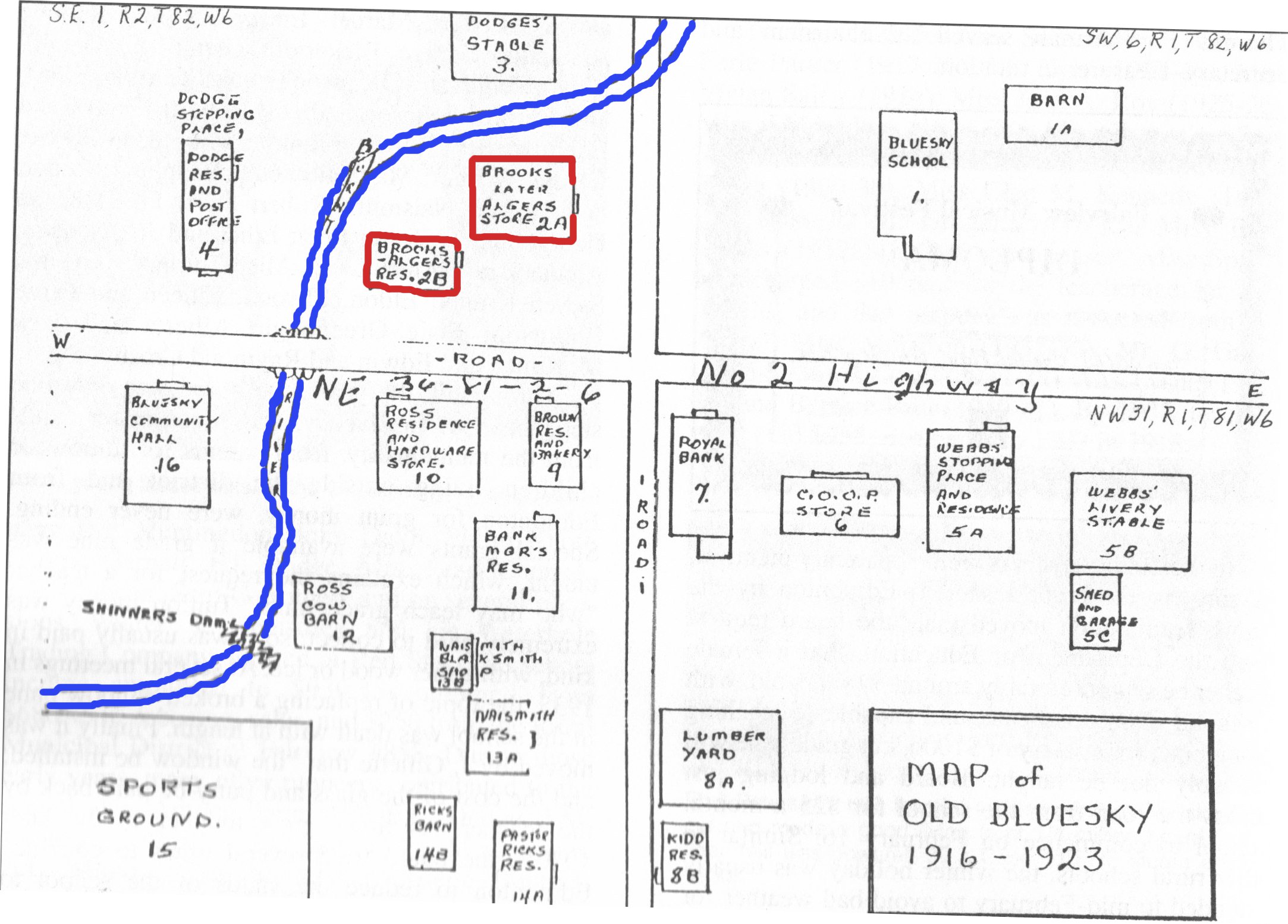
As indicated above, Old Bluesky was close to the Dunvegan Trail (replaced in later years by "Highway 2") so it became a stopping place for travellers which brought business to the Hubert Brooks Store.
DUNVEGAN TRAIL
Fort Dunvegan was established as a fur trading post in 1805 and quickly became the center of the fur trade in the north with the local Indians trapping and trading furs at the Fort. This started the economic growth in the north. The river was the inland waterway leading to the outside world for shipping furs out and goods brought in. The Dunvegan Trail was eventually developed between the Fort Dunvegan and the forks of the Peace and Smokey River. From Dunvegan, travellers passed close to Waterhole and then Old Bluesky before swinging west another 42 miles on their way to the Peace River Crossing. Water and hay from the area made both hamlets popular stopping places. Mr and Mrs Adam Dodge ran a Post Office and a stopping place in Old Bluesky where one could spend the night.
The Dunvegan Trail was a narrow trail cut through the virgin forest. It was unditched and ungraded, smooth enough on higher ground but where it passed through wooded or bushy areas it was deeply rutted and muddy. When it rained, it was one giant continuous mud hole. During the day the sandflies attacked by the billions and then if they didn’t irritate you the pesky mosquitoes did!
The early traders proved that garden produce, grain and grasses could be grown. And in the years to come agriculture flourished. Crops were mostly wheat and oats with the oats used mostly for feed. Yields were good because the land was new.
Over the course of the next 3 years the hamlet of Bluesky would grow to have three general stores, a blacksmith shop, a school, a lumber yard, a restaurant, a bank, a post office, a bakery and a livery stable.
Friday was mail day. The arrival of letters and papers made for a good evening. The Family Herald, Country Guide, Free Press, and Saturday Evening Post had a lot of good reading. Post office was really run by Mrs Adam Dodge -- she was a small person and salt of the earth – she never stopped working. Adam Dodge, the official postmaster, was a fine old fellow with a bright eye and a joke for the ladies.
The following photo images were obtained from the book The Heart of the Peace Volume 1 Fairview and District published in 2005 by the Town of Fairview Alberta. The Post Office (4 on map) was located right across the Burnt River from Hubert Brooks' store, and the hamlet HALL (16 on map) was located right across Highway 2 from the Brooks Store. Unfortunately, no photos are known to exist for Hubert Brooks' Store.
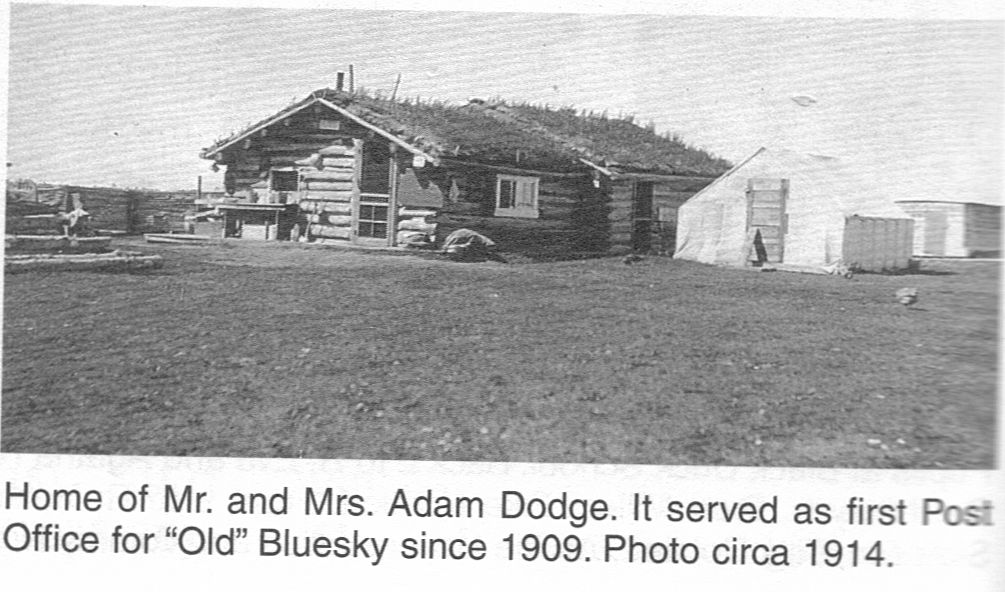
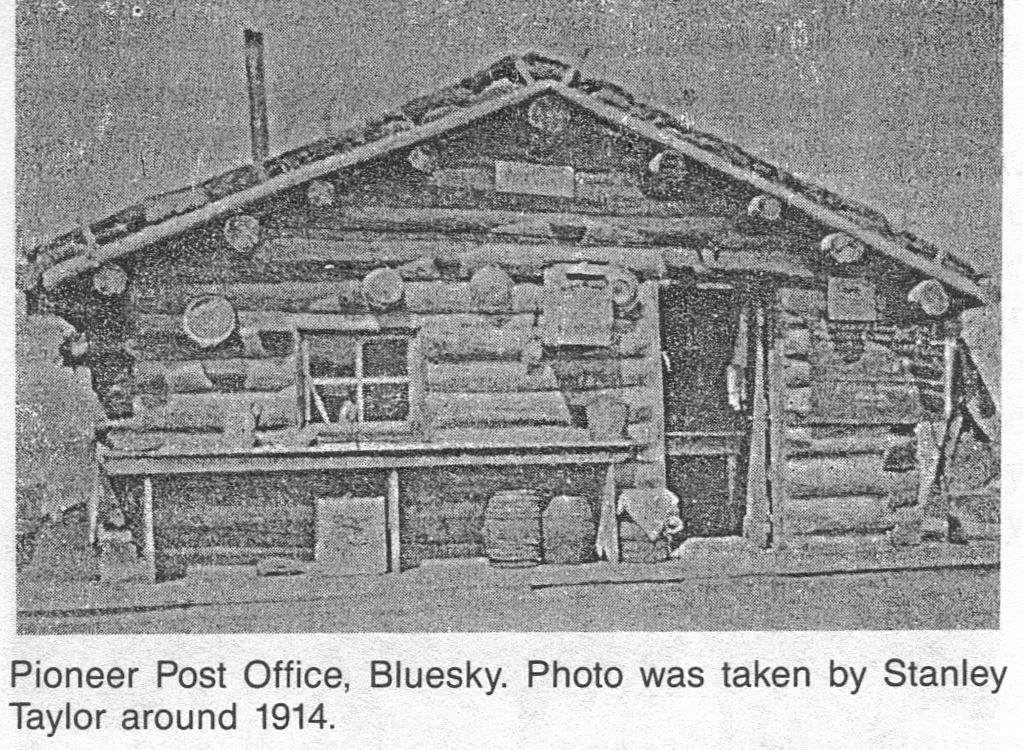

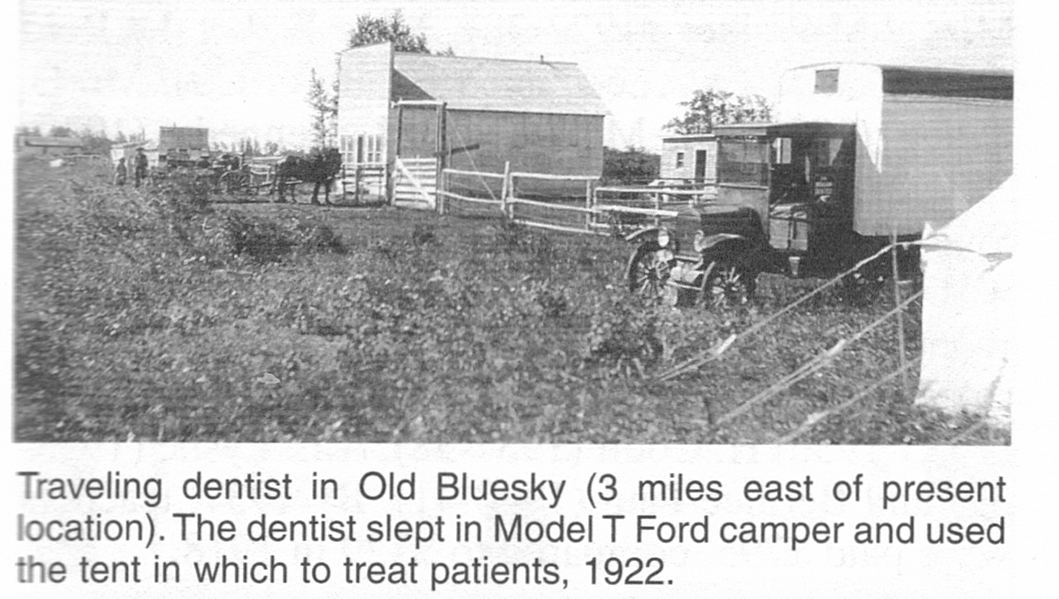

|
In addition to basic food items and clothing, to the delight of the local children, the Brooks’ store carried gum, candy and cough candy -- cheap as most children could afford it.
The experience with the Bluesky Store was a far different experience for Hubert Brooks then he had in St John N.D. Cash
was tight and bartering for store items was common.
Hubert acquired his 1872 Samuel Colt 32 calibre handgun in lieu of money that was owed
the store. He
was quite pleased with this possession as this particular gun used the same shells as used in long guns.
Thus the shells he used in his English
double barrel shotgun
for one of his favorite activities of bird hunting could also be used in his hand gun.

|
Although Hubert Brooks was primarily a (Copenhagen) "snuff man" (smokeless tobacco made from ground or pulverised tobacco leaves) he also did smoke a pipe from time to time. Warren Brooks inherited this original pipe.
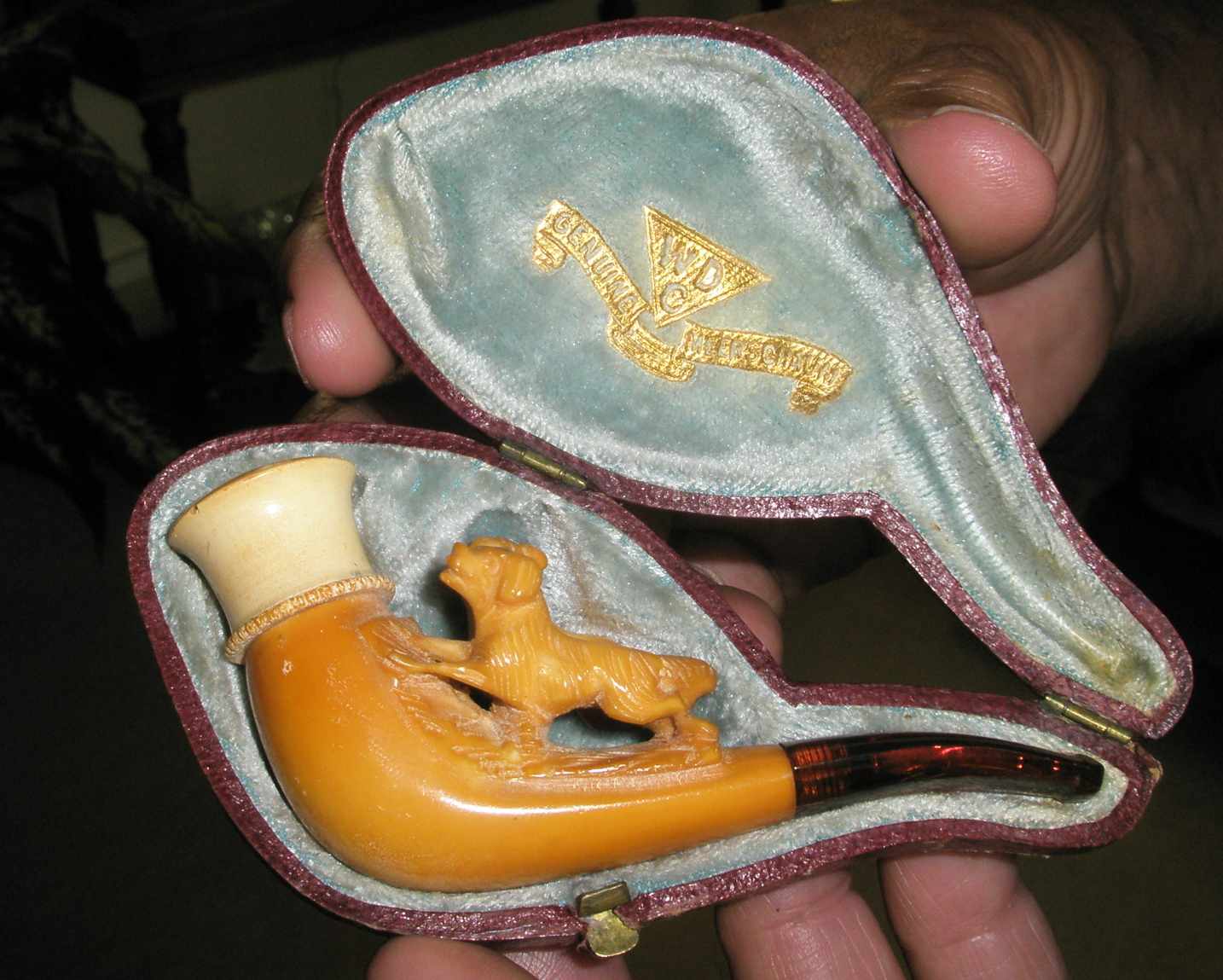
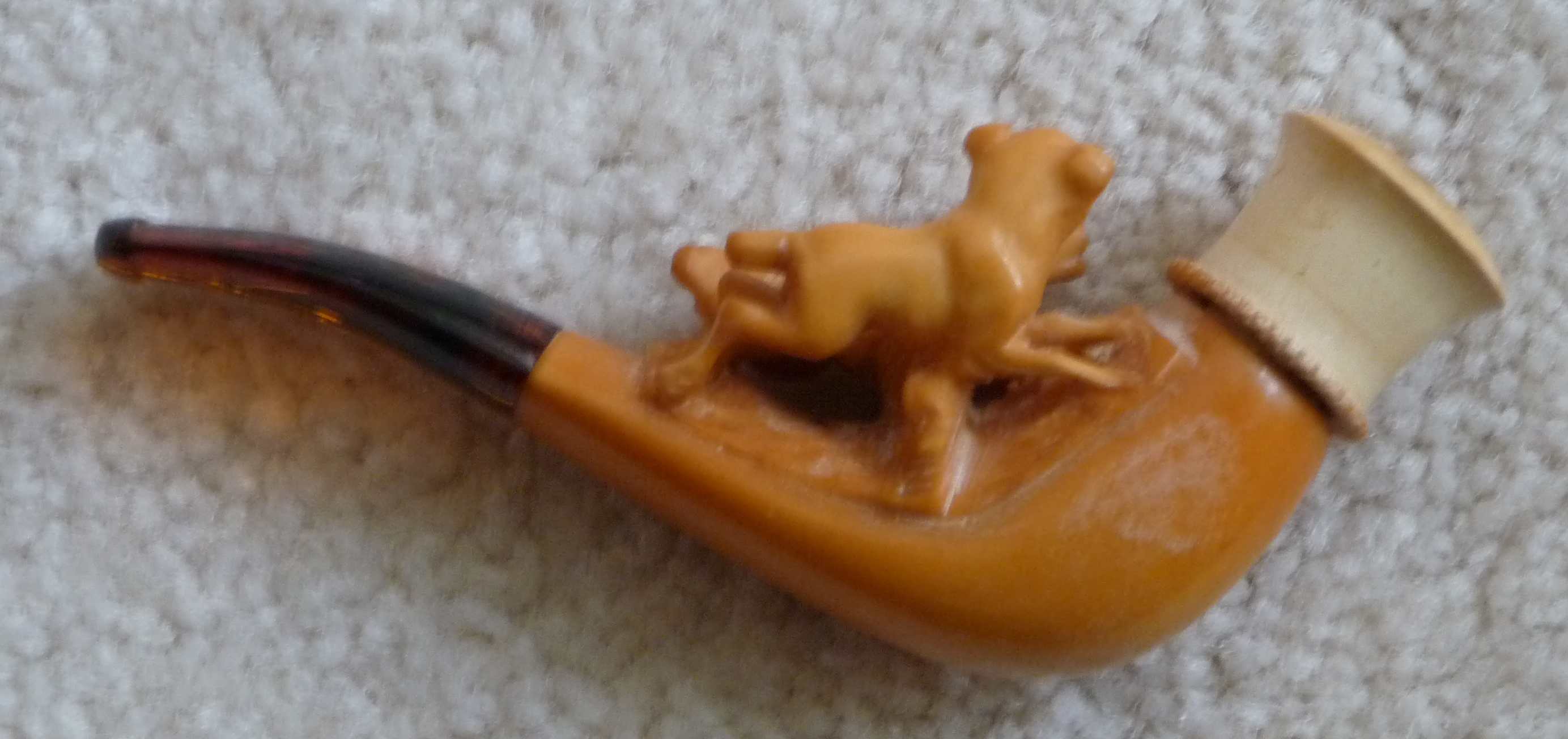
|
The Edmonton based newspaper:
"The Edmonton Bulletin" on Saturday March 10, 1917
on the front page of the Third Section (Page 17) had an article titled :
"Blue Sky District in the Peace River Country Ideal for Mixed Farming; Settlers Doing Well:
A. H. Brooks, of Blue Sky, Tells of some Of the Advantages of District - Much Pure-bred Stock in Vicinity - Settlers Looking Forward to Railway"

In the article, A. H. Brooks, presumably Aimé Hubert Brooks, does an excellent job in describing the advantages of locating in the Blue Sky Burnt River District in the Peace River country. Remarkedly so, for a 23 year old! It is almost as if, the newspaper made a mistake and it was Aimé's father Hubert that was talking - which is given some credance by some of the reference to "A H Brooks & sons" etc in the article.
Nonetheless, the article is an EXCELLENT backdrop to life during these times. The article is reproduced below.
Blue Sky District in the Peace River Country Ideal for Mixed Farming; Settlers Doing Well:
A. H. Brooks, of Blue Sky, Tells of some Of the Advantages of District - Much Pure-bred Stock in Vicinity - Settlers Looking Forward to Railway
An ideal district for mixed farming, leasable land is avalable; about 250 homesteads yet to be taken, with from 40 to 75 acres of clear prairie and balance light brush;
eight inches of black loam on a hard subsoil; abundance of wild grass; fuel and building material convenient; water easily obtainable at springs
and a progressive settlement already started."
........... is the brief catalogue of the advantages which A. H. Brooks of Blue Sky related to the Bulletin regarding the Burnt River district where A. H. Brooks
of Blue Sky
related to the Bulletin regarding the Burnt River district of the Peace River country.
He spent a few days in the city this week on his way to visit friends in Saskatchewan. He is returning shortly to the Burnt River District where
A. H. Brooks and sons
have a store at Blue Sky and a stock farm nearby.
Near the boundary between ranges 1 and 2, west of the sixth meridin the Burnt River flows across townships 82, 84 and 89 from the north into the Peace River
about 45 miles upstream from the town of Peace River.
The Little Burnt River is a stream about 10 to 12 feet wide and two to three feet deep, running all the year round.
It has gouged a deep coulen near the Peace, but further north its valley is not so deep.
Another river, also called the Burnt River, joins the Peace from the southwest, just opposite.
About fifty families get their mail at Blue Sky post office.
Two schools are already organized in the vicinity. They are the Blue Sky school and the Golden Meadow school, each with about 15 pupils.
Anglican and Methodist church services are held at these schools at regular intervals.
The newly organized local of
the United Farmers of Alberta has about thirty members.
The fifty farmers have an average of about 60 acres broken on each farm. Most of them are homesteaders. About five have located scripts.
Plenty of Stock Feed
Wild grass grows about 1.5 high on the prairie and 2.5 tons of wild hay per acre can be cut.
The peavine and vetch, mixed with the other wild prairie plants, makes an excellent feed for the stock both as grass and hay.
Cultivated grasses do well where where they have been tried. Timothy has grown to a height of 2.5 to 3 feet, and brome grass grows three feet high and yields 2.5 tons per acre.
Rape, a valuable forage plant for hogs, grows to a height of 16 inches.
Alfalfa will be tried this year by settlers who have had successful experience with it elsewhere, and are confident of like success at Blue Sky.
In the grain growing department of the mixed farms at Blue Sky, wheat, barley and oats have prevailed, and the best grades of these grains have been grown with success.
Seeding starts from April 25th to May 25th, and harvest begins about Sept. 15th.
Though almost 500 miles north of the US boundary, it must be remembered that the hours of sunshine in June, July and August are much longer in the growing and ripening season of the grain.
The exception proves the rule and for the first time in the six years experience of some of the homesteaders frost came early in August of 1916.
Yet these settlers are more hopeful than ever regarding the success of their district as a prosperous mixed farming centre.
About six pure bred Shorthorn bulls will be brought into the district in the summer of 1917.
Nearly every farmer has a pure bred boar.
In the settlement around Blue Sky it has been estimated that there are about 1200 cattle, 300 head of horses, and about 3,000 pigs, and each farmer has about fifty chickens.
The farming district lies between Blue Sky and the Peace River, and is about twelve miles long and eight miles wide.
Spruce, tamarac, and jackpine timber can be obtained about six miles north of the Blue Sky post office, Freeman Dodge and Messrs. Cook and Hemstock operate two sawmills
in the district, and lumber can be secured at
about $15 per thousand.
During the last couple of years nearly all of the farmers have built or are preparing to build permanent frame buildings.
With the railway facilities ever coming nearer, and even now preparing to cross to their side of the Peace,
there is a more contented satisfaction in erecting permanent structures on their homesteads in this district.
Permanent Improvements
An instance of the permanent nature of some of the improvements is furnished by the concrete dam that H. Brooks & Sons have constructed across the Burnt River,
so as to make a pond 12 feet deep, 200 feet wide, and 150 yards long, for the use of their stock in the winter.
They have 40 head of cattle and 20 head of horses, and about 150 acres under cultivation.
The cattle drink all winter at the water holes which are kept open with little difficulty and without any nessity of pumping.
A little gravel is thrown on the ice near the holes to keep the cattle from slipping.
The dam is 75 feet long and started with a stone pile about 8 feet wide at the bottom. Concrete and stones were piled up till the dam was the needed height, and about 4.5 feet wide at the top.
The cattle and horses cross the creek on the dam to feed on the sunny slope of the other side of the valley.
In the concrete retaining wall a hole 2 feet by 4 feet has been left, and when desired this is plugged by a few boards simply held in place by the pressure of the water.
The stones and the gravel for the dam were easily obtained from the bed of the Burnt river.
Mr. Brooks finds the pond system of watering stock has been a valuable labor saving device.
Adam Dodge, of Blue Sky, started to raise live stock here about four or five years ago with a few head of cattle, and now has about 40 head of good Shorthorn grades.
They winter in open sheds and are fed green feed and hay.
He has about 75 acres broke, and has a set of good log buildings.
During the year he raises about 150 pigs, which are fed on pastures in the summer and grain in the winter.
Mr. Lothrop is located four miles south of Blue Sky, and has had success in the raising of hogs and cattle during the five years that he has been here.
He started with ten head, and now has 65 head of cattle, though he has sold cattle from year to year to keep up his current revenue.
He now has about 100 hogs on hand and raises about 200 to 250 hogs per year.
He is an experienced rancher from southern Alberta and is well satisfied and highly recommends the Burnt River district as spledid for cattle raising.
He winters his cattle in open sheds.
His hogs are wintered in pens, and pastured in summer.
His bunch of 25 horses are headed by a pure-bred Percheron.
John Veal of Blue Sky, was formerly connected with a government experiment station in British Columbia, and he is making use of his experience with added success at Blue Sky.
He farms scientifically as he did on his experimental station. He will try alfalfa this year, and is confident of success.
He has impicit faith in the district as a result of his four years' residence in Blue Sky.
He has about 15 head of very fine cows.
He has specialized on the raising of pure-bred hogs, and has about 100 pigs each year.
His cattle are of the beef type of pure-bred Shorthorns. In the poultry department he raises purebred Barred Plymouth Rocks.
The success of many other residents of Blue Sky might be quoted, but these should be sufficient to show that the residents of the Burnt River District in the Peace River country are proving Blue Sky to be ideal for mixed farming.
Around 1918-1919 Hubert Brooks sold his store in Old Bluesky to Fred E Algar of Peace River, following the "one-two punch" of:
a) first on July 23rd 1918 a rare extremely hard summer frost occured that essentially wiped out the grain crops and the gardens
causing a severe financial strain and hardship on the settlers with the loss of crops but also of grubstake for the coming winter. There were not a lot of people with spare cash. What cash they did have saved was reserved exclusively
for urgent necessities. Faith in the agricultural possibilities of the area were considerably shaken by the crop failure;
and then
b) in the winter of 1918-1919 a severe Spanish Flu outbreak
occured in the western portion of Canada.
The flu outbreak was bad in Old Bluesky with many families affected. There were many deaths due to no close doctors and no money. The Old Bluesky school house had to be turned into a hospital.
Also in that year, the winter weather at times was quite severe with much snow and temperatures dropping as low as minus 60.
Business obviously was very bad in Hubert Brooks' store. People just did not have money to spend.
Hubert and sons were to then take up the cattle and farming businesses. Interesting times lay ahead.
Several years later, when the steel (railway) stopped 5 miles east at Whitelaw Fred Algar moved the stock and store to Whitelaw.
A further article appeared in
The Edmonton based newspaper:
"The Morning (Edmonton) Bulletin" on Tuesday December 9, 1919
on the front page had an article titled :
"Peace River Progress"
... where A.J. Brooks provided the newspaper with some feedback as to what was transpiring in Bluesky. Again its instructive to get some sense as to the happenings at that time.

|
PEACE RIVER PROGRESS A. J. Brooks of Blue Sky, Peace River, is in the city on a business trip. He reports good crops last season in country north of the Peace. There is a large crop aceage and wheat, and oats and barley yielded well. Balley Brothers, south of Waterhole, have 45,000 bushels of grain. They are 60 miles from the end of steel at Peace River. They are 30 miles from the railway at Spirit River, but the valley of the Peace is over 800 feet deep at Dunvegan and hauling across the valley is fearful work. The river is not yet frozen over hard enough to carry teams. Teams are hauling grain to Peace River town at the rate of about 100 a day. The elevator is full and men are buying lumber and making bins in which to temprarily store their grain. The hotels in town are crowded. There is a large amount of southern cattle in the country, distributed amongst the farmers in small bunches. Mr. Brooks is looking up registered Shorthorns with a view of improving his heard. |

|
| PREVIOUS PAGE | GO TO TOP OF PAGE FOR APPENDIX NAVIGATION MENU |
NEXT PAGE |
The Life and Times of Hubert Brooks M.C. C.D.